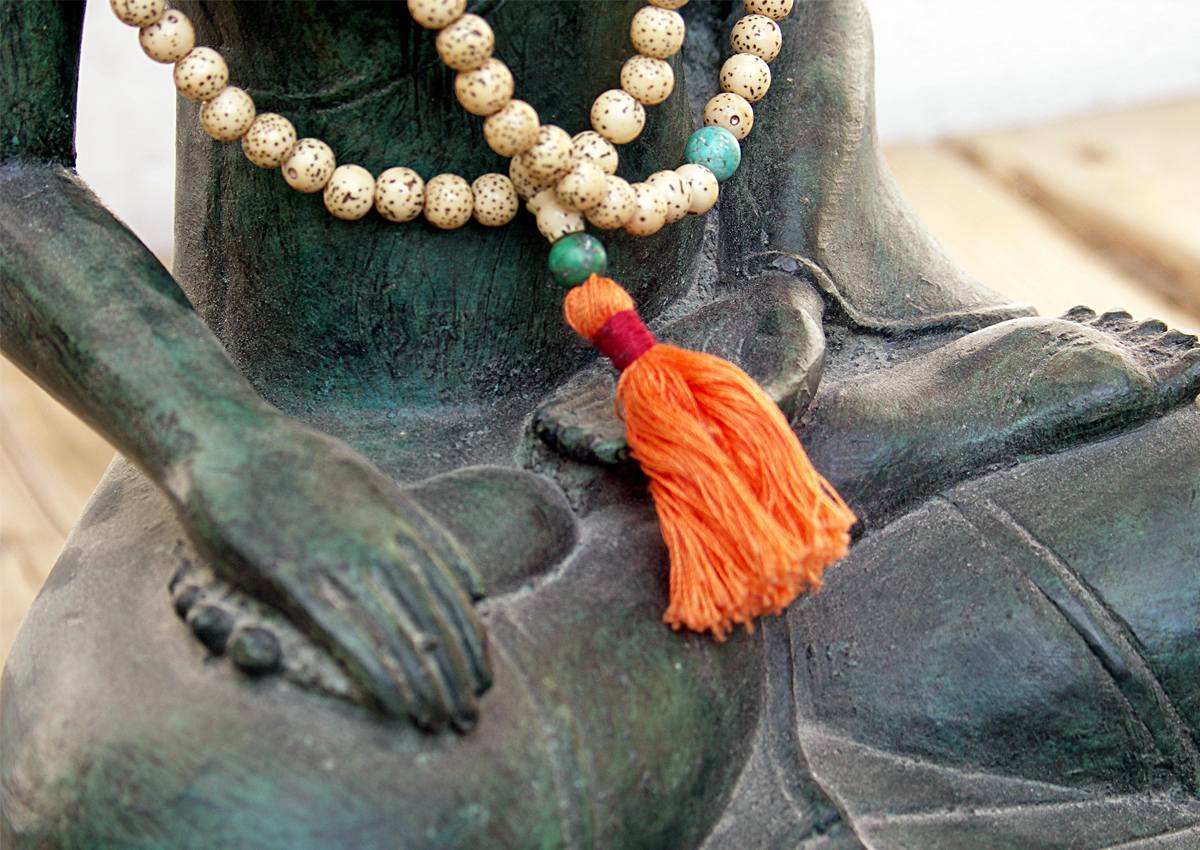
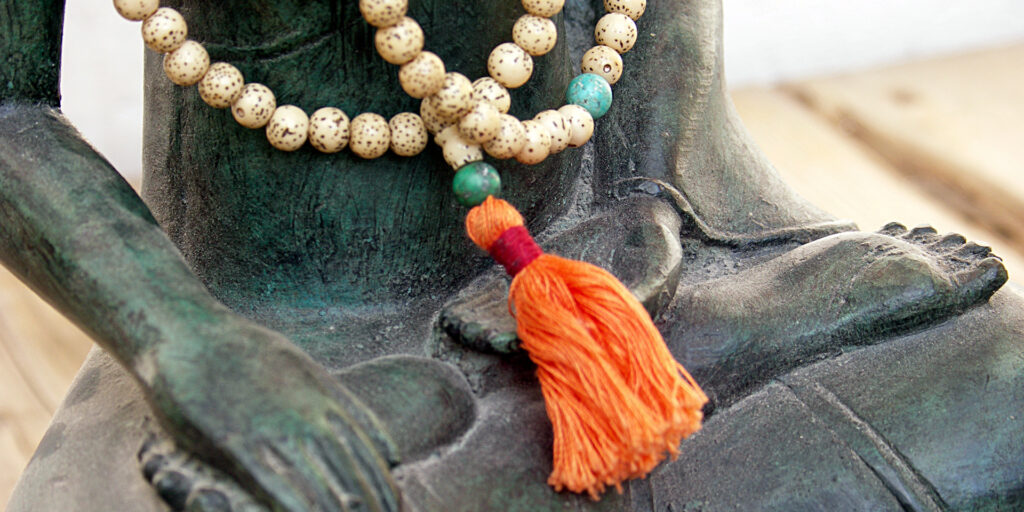
The Mala is one of the most used tools in meditation, it can be defined as a sort of meditative rosary which has the function of keeping track of the number of mantras recited during a meditation, or it can simply be a sacred object to carry with you.
The word Mala comes from Sanskrit and literally means crown or garland. In the Sanskrit language the noun is feminine, but in the West it is often used in the masculine because the sound is more fluid.
It is a necklace made up of 108 beads plus a final bead called Guru, which is generally larger than the others, its purpose is to signal to the practitioner that the counting is finished, it symbolizes the relationship between disciple and master.
Another element is the tassel, that is the bunch of threads found in the lower part under the Guru stone, its length is variable and represents our connection with the divine.
Origins and history of Mala
Malas are instruments originating from India and date back to the eighth century BC. However, their use spread widely in central and eastern Asia, soon being adopted by the Hindu and Buddhist religions and giving rise to different types of Mala. The rosary used in the Catholic religion is also a type of Mala.
The ancient seers of India immediately began to use beads as a meditation tool with the desire to experience increasingly intense degrees of concentration and realization.
A 4th century BC text, known as the Mokugenji Sutra, tells the story of a king who sought the teachings of the Buddha to learn how he could share the wisdom of Buddhist teachings with his people. According to the Sutra, the Buddha replied to him:
“King, if you want to eliminate worldly desires and end suffering, create a circular thread of 108 beads made from the seeds of the Mokugenji tree. Always keep it with you. Recite “Namo Buddha – Namo Dharma – Namo Sangha”. Count one bead with each repetition.”
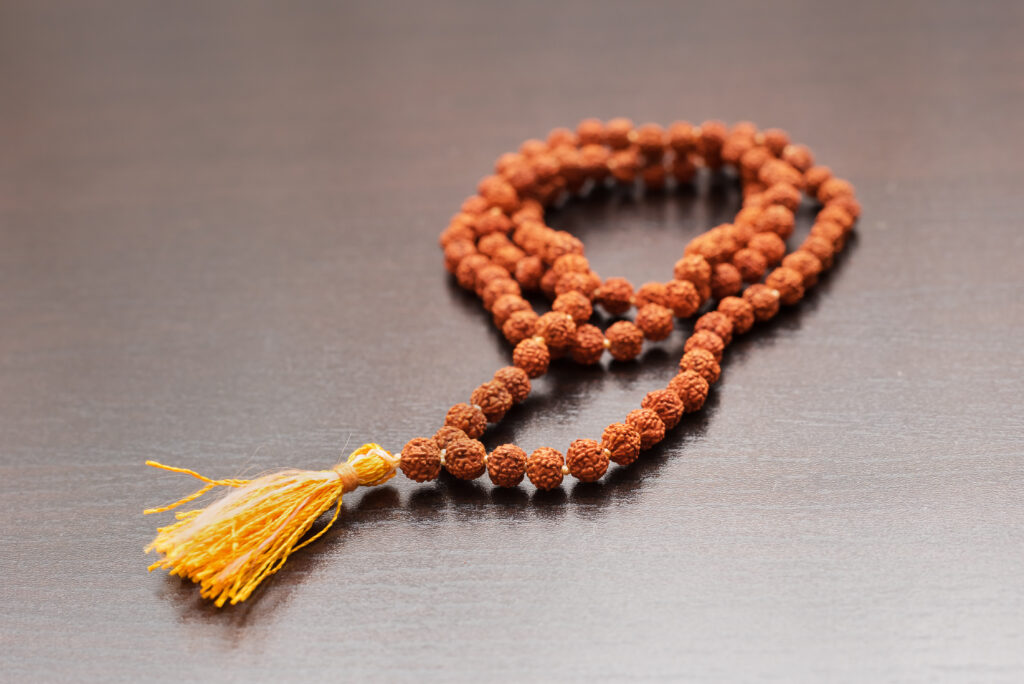
How a Mala is made
The Malas are composed of:
- 108 grains: the grains are the beads that make up the Mala necklace and are traditionally hand knotted one by one, in order to make the necklace stronger but also to give the perfect amount of space between the beads. The diameter of the grains is variable, but is usually between 6 and 8 millimeters.
- A guru stone: the guru stone is the largest stone of the Mala, located at its lower end, and is not included in the count of 108 mantras. The purpose of the guru stone is to signal to the practitioner that the counting is finished. It symbolizes the relationship between student and guru and must be respected, in fact, traditionally one never passes over the guru stone, but rather uses it to turn the Mala and start the counting again.
- A tassel: the tassel is the cluster of threads found at the bottom of the Mala, under the guru stone. Its length is variable and each thread of the tassel represents our connection with the divine and the universe.
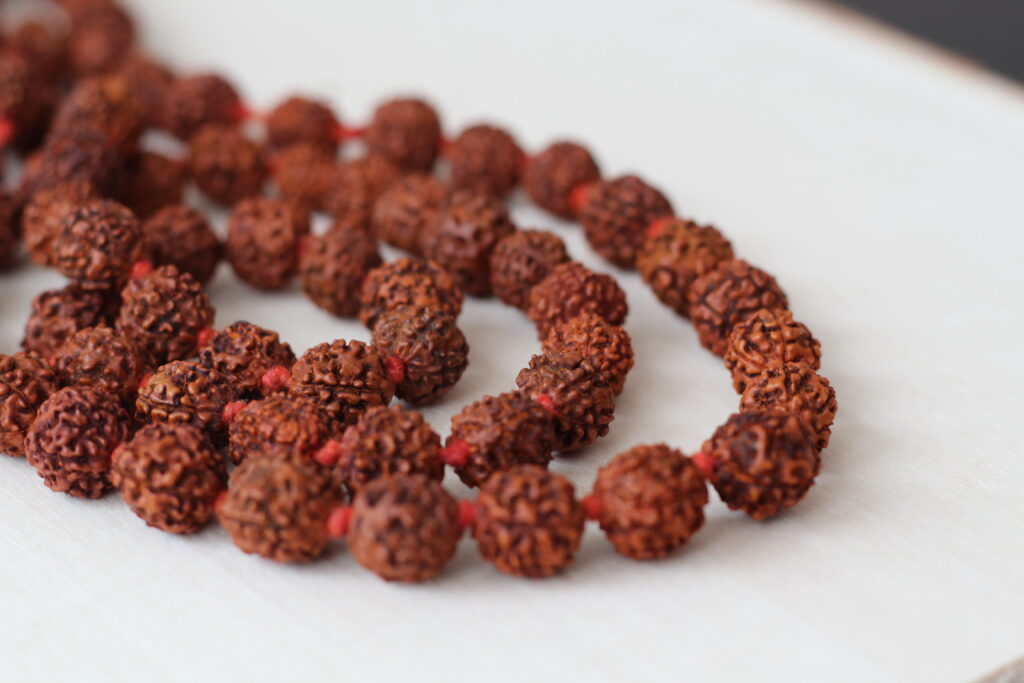
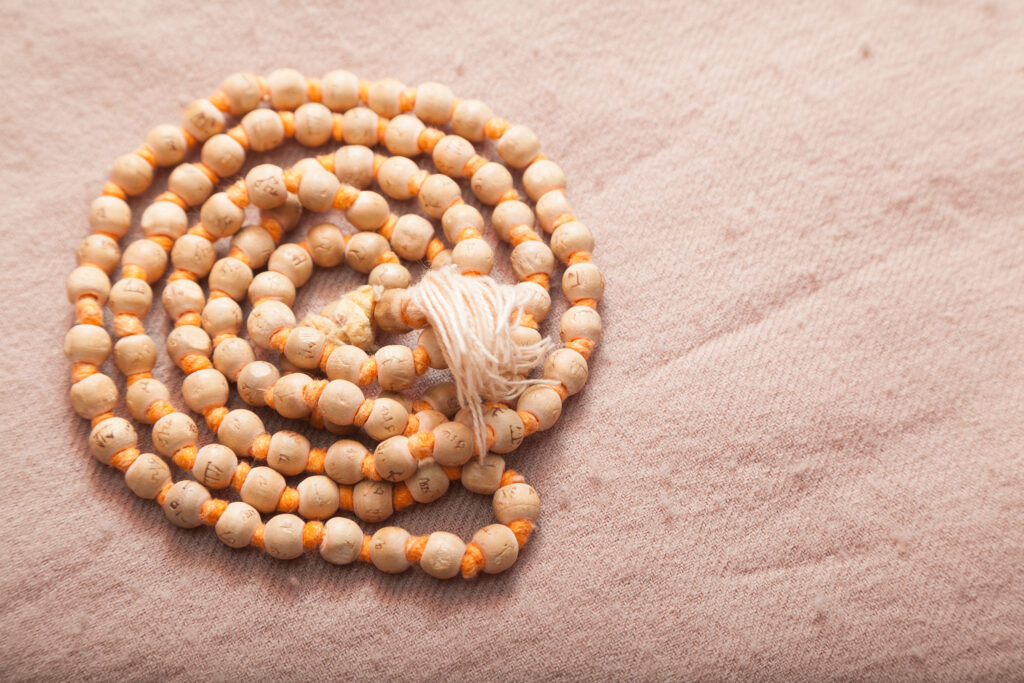
The first Malas are thought to have been made of seeds or local woods from the Asian regions, such as sandalwood, rudraksha seeds, Bodhi seeds, tulsi seeds and, in the Tibetan regions, also Yak bone, turquoise, coral and lapis lazuli, materials much loved by Tibetans and also popular for making jewellery.
Only with the spread of Mala in the West did people begin to use any precious stone that has energetic properties, such as rose quartz, hyaline quartz, amethyst, agate, silver, etc. Crystals are perfect for Malas, as they further enrich the object with the numerous benefits of crystal therapy.
The Mala thread can be made of any material, as long as it is resistant to wear.
The meaning of the number 108
The number of beads in a Mala is not random, in fact, the number 108 is considered particularly significant in Hinduism, Buddhism and the yogic tradition, it is a number that is often found in many spiritual and cultural aspects of the populations of Asia. For example:
- the number of chakras or Nadis is 108
- from an astronomical point of view this number occurs several times: there are 27 constellations each with 4 directions, multiplying these two numbers gives 108
- the diameter of the sun is 108 times the diameter of the earth
- in the Sanskrit alphabet there are 54 letters, each letter has a male (Shiva) and a female (Shakti) energy, multiplying 54 by 2 you get the number 108.
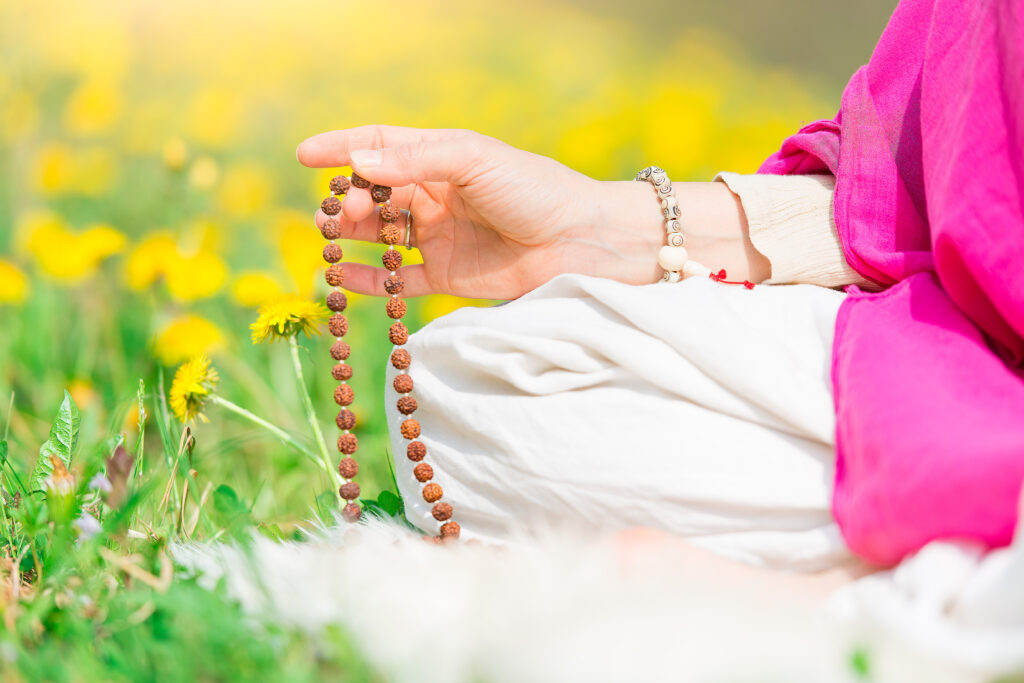
How to use Mala
The use of the Mala in meditation resembles that of a Christian rosary, but there are some important precautions to take into consideration.
- Hold your Mala in one hand.
- Take the first sphere with your thumb and middle finger (you start counting immediately after the Guru stone).
- Breathe in and out deeply.
- Move your fingers to the next sphere and for each sphere recite your Mantra in your head or in a whisper, moving your fingers to the next sphere and repeating your Mantra while exhaling.
- When you arrive at the guru stone you can end the meditation or, if you wish to do another cycle, rotate the Mala by grasping the guru stone with two fingers and start again in the opposite direction until you reach the guru stone again. Do not pass over the guru stone continuing in the same direction, but always rotate the Mala to change direction.
How to choose the most suitable Mala for you
Malas, in addition to being tools to increase concentration during meditation, can also be worn as protection and auspicious amulets.
The grains can be 108 or less, depending on their size, as long as they are multiples of 9.
Wearing a Mala allows you to create a sort of bridge of connection with the divine plan and certainly the material it is made of also contributes to creating this connection, so this is a very important aspect to consider.
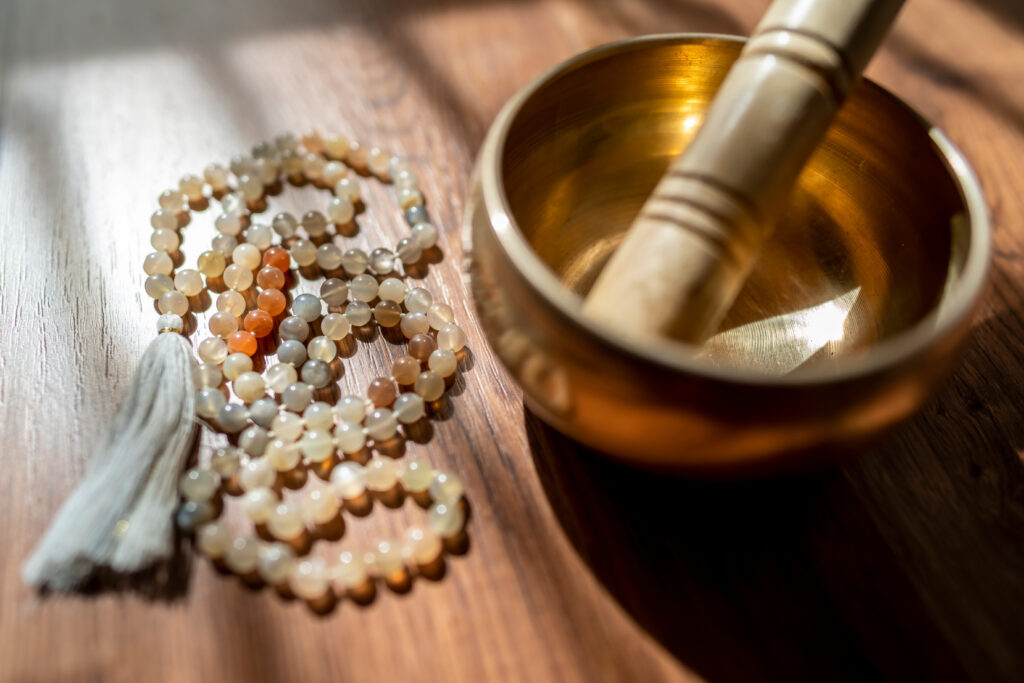
Here are some useful tips to better orient yourself in choosing your Mala:
- Let yourself be guided by your instinct: on an unconscious level we always know what energies we need and if we feel attracted to a particular Mala, it is often a sign that it is the most suitable one for us.
- Choose materials associated with your weakest chakras or those that need energy the most, so the choice can be oriented towards the color or material that makes up the Mala.
- Consider the size of the beads and their surface area: a Mala made of 6 millimeter beads will be shorter than one made with larger 8 millimeter beads. Another characteristic to consider is whether the surface is smooth or rough, cold or hot.
- A very important aspect is to ensure that the grains are natural, whether they are seeds or crystals, it is essential that they have not been artificially colored or, even worse, that they are not resins or plastics that imitate natural materials.
Activate and heal the Mala
Once you have purchased your Mala, you will need to activate it to begin creating a dialogue between the two energies. If you have the opportunity to have it blessed by your Spiritual Master or to be able to place it for a period on an altar or in a sacred space, the Mala will certainly be imbued with blessings.
Fortunately, however, each of us can activate our own Mala or purify it through the recitation of some specific Mantras.
To clean the Mala in a more material sense, you can act by cleaning grain by grain with very few drops of essential oil or almond oil, if it concerns seeds or wood, or with a cloth soaked in water and coarse salt if it concerns stones.
When not in use, the Mala should be kept in a small bag dedicated to it, it should not touch the ground during practice and in general it should be used with great respect.
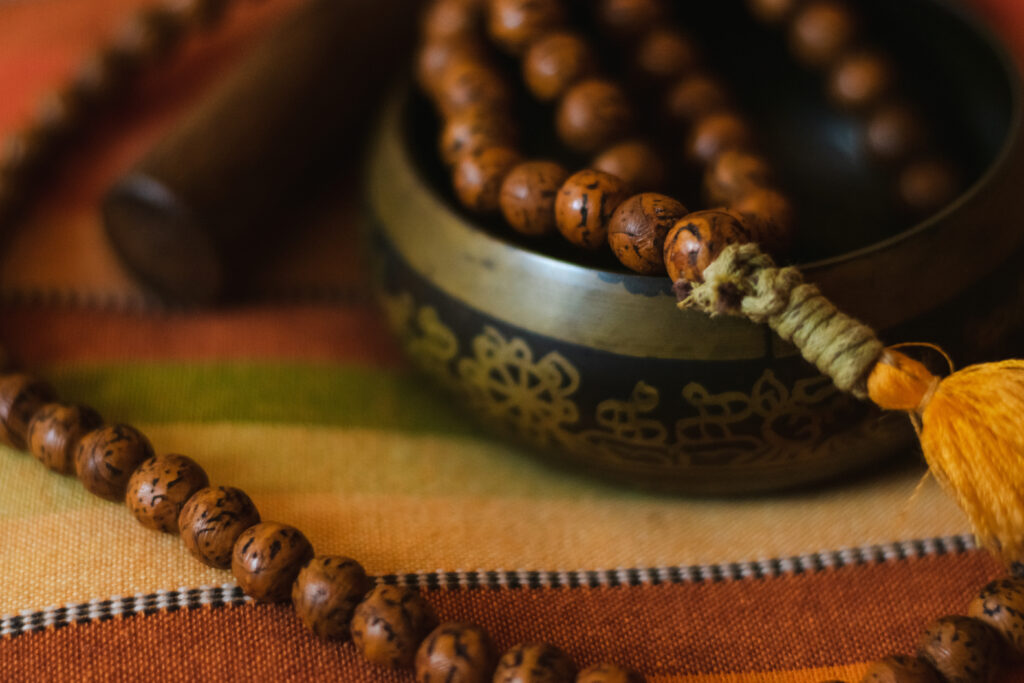
In case of breakage
In the culture of Tibetan Buddhism, when an object breaks it is considered as a sign of something that has ended, or a message to be interpreted, or simply something that has accumulated such an energetic load as to cause a break, thus releasing tension.
If it happens that your Mala breaks, it is important to think about the meaning of this event, the time in your life when it happens and the events that may be connected. However, there is no need to ruminate and force yourself to look for a reason, if this thought does not come, simply let go, say thank you, be grateful for the service that your Mala has done for you and move on.
Obviously, once broken, the Mala can be repaired but it is important to recognize this passage by trying to leave a sign of what happened or by changing it completely, giving life to something new as a sign of continuity and renewal.
A Mala helps to turn on our inner light, it becomes a personal object that takes on a value given by the unique exchange that takes place between our energy and the energy of the Mantras, conveyed by the material the Mala is made of, generating a particularly useful synergy for our spiritual journey.